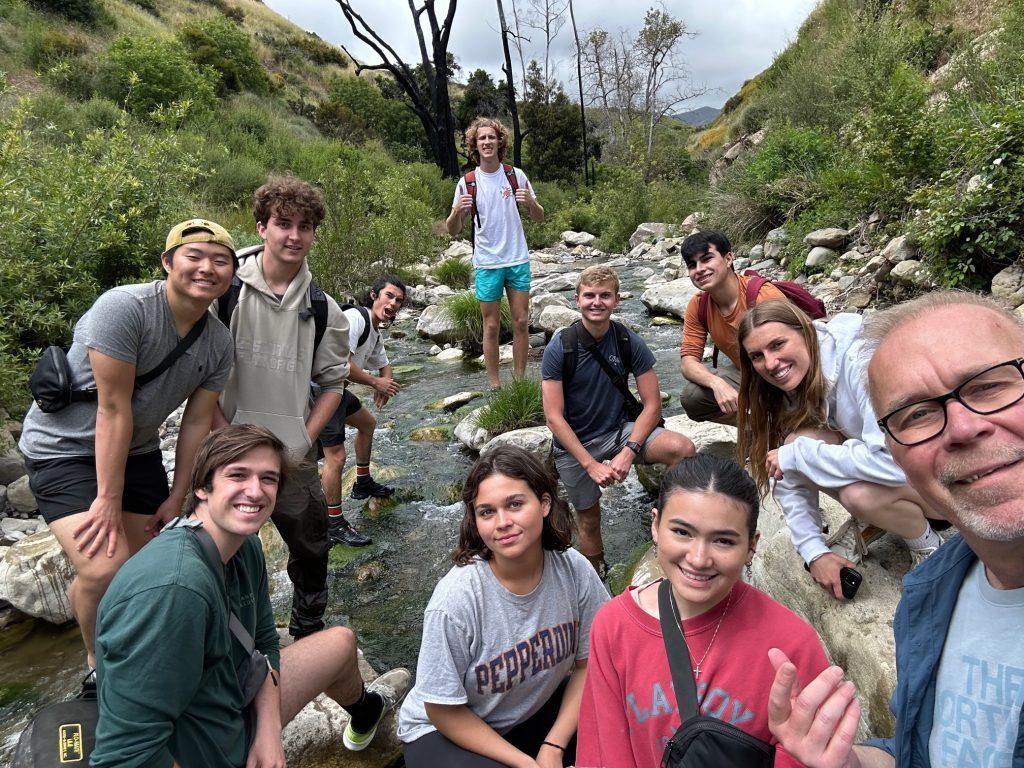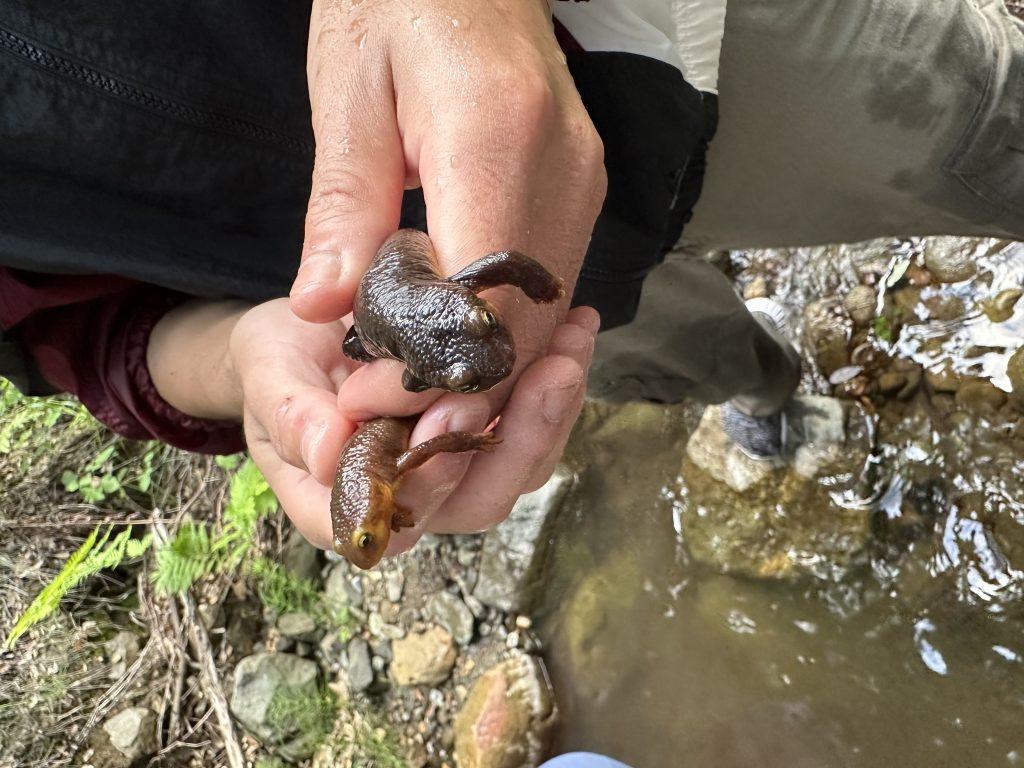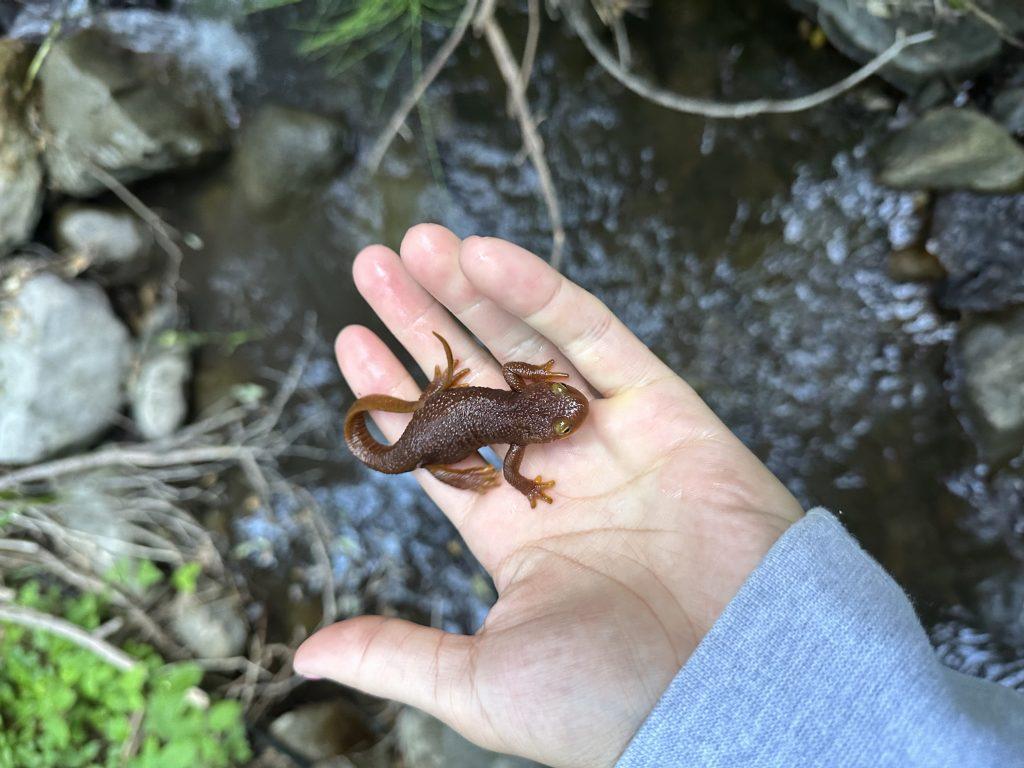Following heavy rains during the Fall 2023, the waterfall at the bottom of Newton Canyon sprays a plume of water. Constant sources of water are vital to local amphibians such as frogs, said Allison Sacerdote-Velat, curator of herpetology at the Chicago Academy of Sciences.
The trail to Newton Canyon is uneven and unkempt; a stony vein, narrow and devoid of vegetation. It leads to a drop-off that is only a mild climb down if both hands are free. A river runs through it, teeming with frogs who hop out of volcanic-looking holes in the stone. A waterfall lazily sprays above. A newt, burnt orange muddled with a brown underbelly, clings to underwater vegetation as a garter snake slinks past, trolling the waters for tadpoles.
Places such as this are one of the reasons she loves living in Malibu, said junior Christine Espinosa, a member of the Pepperdine community garden. However, due to recent drought, both the rivers and the wildlife the water attracts are increasingly seasonal.
“It’s so beautiful when all the hills turn green after a rain,” Espinosa said.
Over the past three decades, Lee Kats, interim dean of Seaver College and freshwater ecologist, said he has observed streams in the Santa Monica Mountains that were once consistently active dry up — an unprecedented phenomenon correlated with climate change. This, along with other human intrusions, has caused ecological pressure on local animals throughout the Santa Monica Mountains.
“For my first decade working here in the mountains, I didn’t know any different,” Kats said. “I could go to the same streams; it didn’t matter if it was July or November, and it’d be water flowing.”

Dwindling Water Impacts Wildlife
Kats and his team survey a variety of sites within the Santa Monica Mountains, including Newton Canyon, as part of a continuing three-decade old research effort observing the local amphibians, such as frogs.
Much of the life cycle of the frogs Kats studies is dependent on reliable freshwater environments, said Allison Sacerdote-Velat, curator of herpetology at the Chicago Academy of Sciences.
“When you’re trying to reestablish new populations, that increased drought frequency really knocks them back,” Sacerdote-Velat said.
Kats said the pristine freshwater streams in the Santa Monica Mountains are rapidly shrinking.
“It seems to me animals are more stressed,” Kats said. “And I don’t just mean psychologically stressed, I mean physiologically stressed.”
The most powerful example of this was a recent population-wide disease among the native newts, Kats said.
Members of Kats’s research team hold captured newts at a survey site in the summer 2023. The research team measures and weighs the newts on-site before being returning the amphibians to their habitat. Photos courtesy of Nolan Gentile
“So what happens is if you’ve got stressed organisms,” Kats said “And then you put an additional stressor on top of that, you see that they’re vulnerable.”
Kats said he compares this experience to people, who tend to get sick when low on sleep or are under stress.
“When you see that the Woolsey Fire happened, and that it dramatically alters the stream bed because silt washes in and ash washes in, that’s got to be stressful,” Kats said. “This is a correlation.”
The nature of field biology makes it difficult to prove causation between these factors, Kats said. However, he points out incredibly strong correlations between the data.
“Any time people talk about climate they’ll say, ‘Well, what proof do you have?’” Kats said. “It’s hard to connect things directly to climate change.”
Human Activity Impacts Wildlife
In addition to the Woolsey Fire, Kats also cites construction projects and human activity near water ecosystems as stressors. One survey site, Cold Creek, has been affected by a golf course upstream, which introduced non-native fish and nutrients from the fertilizer into the water.
“They’re [reptiles and amphibians, such as frogs] also incredibly vulnerable and incredibly sensitive to things like road salt getting into the environment,” Sacerdote-Velat said. “Or other forms of pollution that might be present.”
Reptiles and amphibians are not the only animals affected, Biology Professor Javier Monzon said. Monzon’s research focuses on the impact of urban developments on coyotes. Typically, coyotes are looked at as a versatile species — they’re resilient to changes to their environment — and inhabit suburbs and sierras alike, Monzon said.
“We discovered that with greater degrees of urbanization, there’s less genetic diversity in coyote populations,” Monzon said.
This was in comparison to populations in less populated areas, Monzon said, such as Montana and Wyoming. The research painted a picture of small, fragmented and isolated bands of coyotes, cut apart by urban development.
Monzon said he envisions two possible scenarios that could have caused the observations. The first hypothesizes that the construction of Los Angeles and its surrounding urban areas displaced coyotes. The current populations, Monzon said, would then be descended from the select few coyotes who returned a generation or so later.
“The other scenario is that the building up of L.A. didn’t displace coyotes, but reduced their populations,” Monzon said. “The modern-day coyotes are descendants of the few individuals that remained.”
Monzon said in both scenarios, when the remnant band of coyotes eventually reproduced, their descendants only had the limited genetic makeup of that remnant, leading to the observed reduction in genetic diversity.
“In the jargon of population genetics, that’s called a bottleneck,” Monzon said. “You take a population that’s large and it shrinks for some reason, and then it expands later on. After they go through that shrinking bottleneck, the descendants have much less genetic diversity than the original.”
A depletion of genetic diversity diminishes the ability for a species to survive and adapt within a changing environment, according to Monzon’s research. Sacerdote-Velat said this bottleneck also occurs with frogs when sources of water dry up.
“One of the things that I’m really excited about is the construction of the wildlife overpass in Calabasas,” Monzon said. “That wildlife bridge is very promising because it is likely to provide connectivity to many different species.”
The bridge, when completed, will span 174 feet wide and 210 feet long, said Micheal Comeaux, California Department of Transportation public information officer.
“For comparison, if this was a bridge designed for traffic, for cars and trucks, it is big enough that it could have five or six lanes in each direction,” Comeaux said.
The bridge will have a layer of native dirt and plant life to integrate it seamlessly into surrounding habitats, Comeaux said.
A pair of Pacific Tree Frog tadpoles rest on the lakebed of Newton Canyon in Fall 2023. Pacific Tree Frogs are identifiable by their mottled appearance. Photo by Max Pohlenz
Threats such as urban encroachment are real issues, Kats said. The threat of climate change, however, which looms over the drying streams and the hot summers, Kats said, is far more existential. Much like a proverbial bird smashing into glass, local species will continue to find themselves hurtling into man-made situations that they are not adapted to, Kats said.
“Birds are not equipped for the most part to deal with glass and that’s why thousands of birds a year, probably millions of birds a year, fly into glass and die,” Kats said. “That’s a conservation question, that’s a behavior question that is connected to conservation, because it’s an animal that has a trait that’s not perfect for the environment.”
_________________________________
Follow Currents Magazine on Twitter: @PeppCurrents and Instagram: @currentsmagazine
Contact Max Pohlenz via email maximilian.pohlenz@pepperdine.edu



